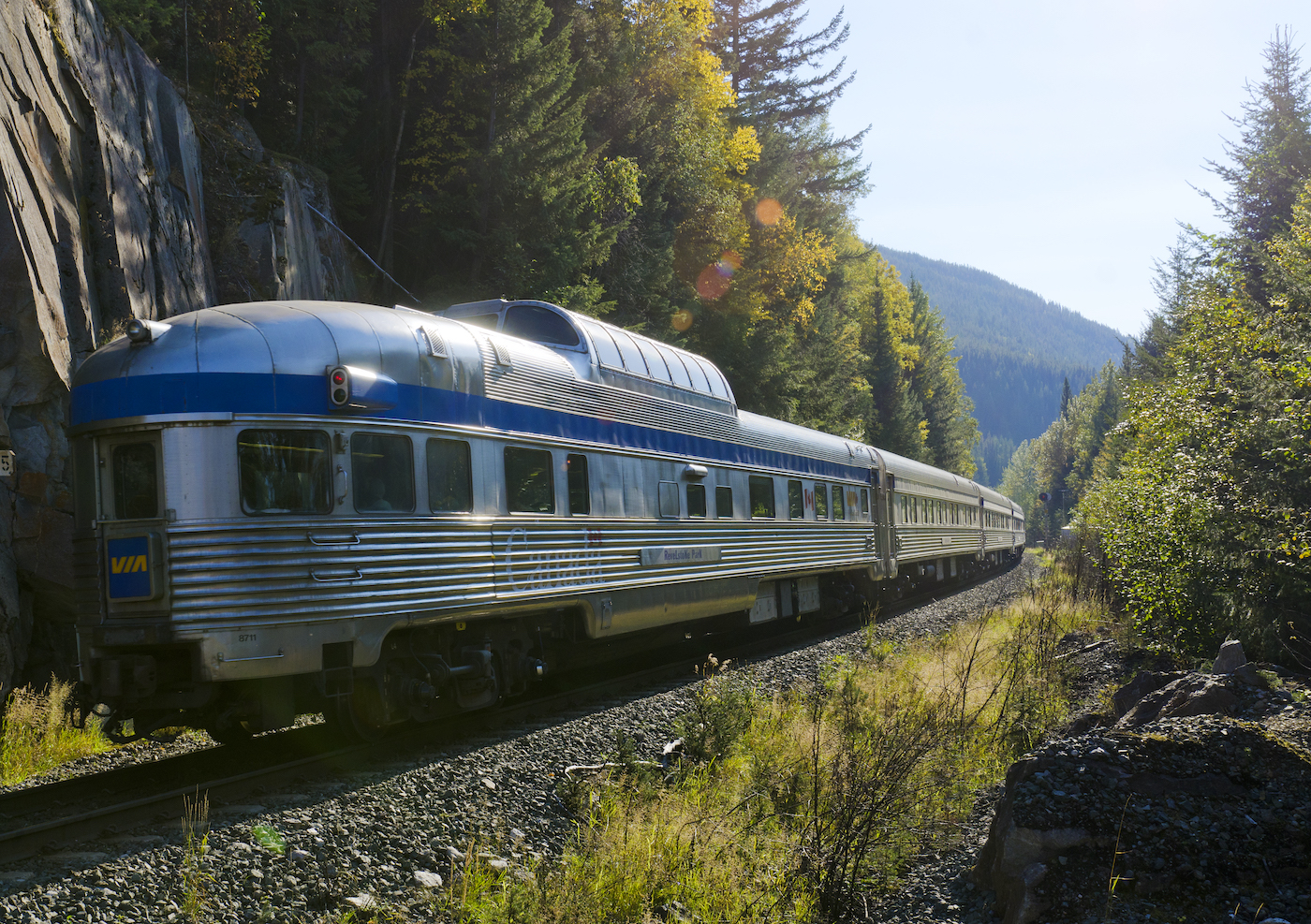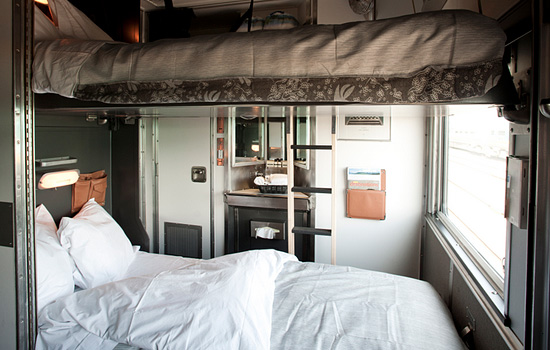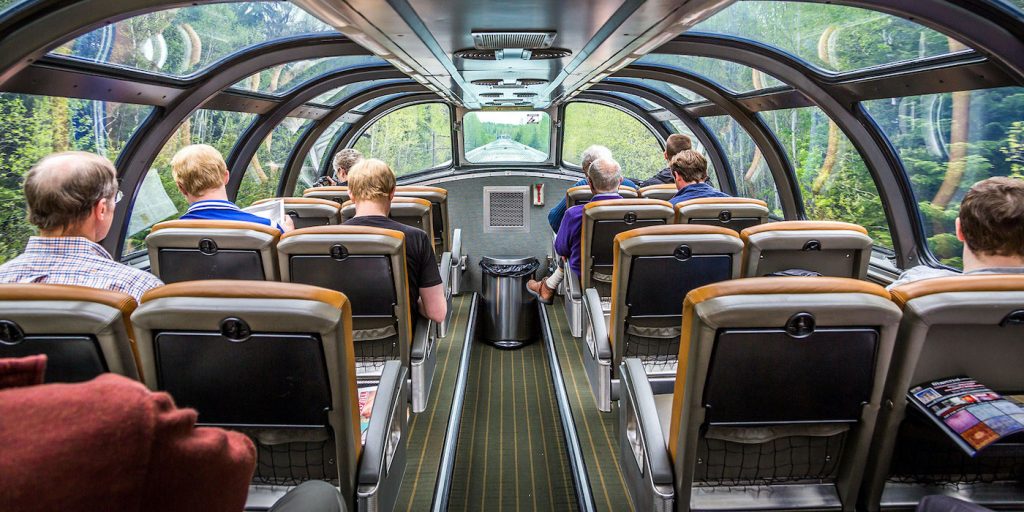Across Canada by Train:The Brochure vs. the Reality

It was ten at night, and two weary travelers stood at Track 17 at Toronto’s Union Station, waiting to board The Canadian. The brochure for this flagship of Canada’s VIA Rail system had promised “comfortable accommodations” in “superior sleeper cabins,” and we were filled with the anticipation of looking out our window as the train glided past “gentle prairie fields, rugged lake country, and picturesque towns to the snowy peaks of the Rockies . . . with ease, comfort, and exceptional service.”
Then my wife, Merry, and I climbed the metal steps up into Car 113, opened the door of Compartment C, and saw a room for which the word “small” didn’t begin to cover it. Our superior sleeper cabin was a box that measured seven feet, three inches on a side.
I’m 6’6” just by myself.
The friendly car attendant, Marty Duclos, had let down our stacked upper and lower bunks and made them with crisp white sheets. The bunks, however, left only enough space in the compartment for one person to sidle sideways. With two of us in the compartment, to get to the sink or window we had to plan strategic moves. It was like one of those little puzzle games where you slide one tile over and one tile up.
Whoever had shot photos of our Sleeper Plus Class cabin for VIA Rail’s glossy brochure must have stood out in the hallway with a wide-angle lens.
Marty opened the door to our private commode, helpfully explaining how to flush: We were to push the “WC” button, not the call button for the attendant. “There are a lot of things I can help with,” he said with a twinkle, “but usually that’s not one of them.”
The Canadian’s cars date to the mid-1950s, the era of silver streamliners. They’ve been preserved, if not much updated. Marty advised: “Close the sink drain at night. It sounds silly, but it reduces the noise from the tracks below.”

I wondered where to stow our two carry-ons, given that the closet was a slot in the wall maybe five inches wide. I managed to slide Merry’s suitcase under the lower bunk. Mine went on a shelf high above the sink. Soon we’d be wrestling stuff out of these bags – toothbrushes, nightgown, Kindles – and I’d climb the ladder to the upper bunk for the night.
First, though, we had a laugh taking a photo of me lying on the lower bunk with one foot straight out and the other foot stuck through the rungs of the ladder, my legs splayed. In the tiny cabin, Merry couldn’t stand far enough back to fit all of me in the camera frame. She had to take three pictures and make a panorama.
After a decent night’s sleep, I turned my thoughts and eyeballs toward the scenery of Canada. For three days and nights we’d roll westward. The Canadian travels from Toronto to Vancouver, a journey of 2,775 miles. (Merry and I would get off, though, around the three-quarter mark, at Jasper in the Canadian Rockies.)
Riding the train is a great way to make sense of a country as huge as Canada. As landscapes appear and change out the window, and change again, you get a first-hand geography lesson. And trains run through the back country, far from highways, giving you rare views of hidden territory. In small towns, you see the backyards and alleys that often reveal more about a community than the tidy main street.
At 6:30 the next morning, we awoke and undertook some assembly of our persons – i.e., grabbing my rolled-up jeans from above the sink and tugging them on as I lay on my top bunk. Then we headed to the dining car for breakfast. (Meals are included with sleeper tickets. The food is good, and the menu changes daily.)
The entrance to the dining car was handsomely decorated with etched glass panels depicting birds, like Audubon prints. Our breakfast – mushroom omelettes, muffins, orange juice, coffee – was presented on white china and white linen. We were joined by a woman who lives on a Saskatchewan farm. Her husband, inexplicably, was sitting in another car in an economy seat. (Apparently she’s not that fond of him.) She told us that each year their bees produce 84,000 gallons of honey, enough to fill two semi tractor-trailers. Such are the stray facts you pick up from fellow passengers on a train.
During the night we had crossed onto the Canadian Shield, a region of exposed, billion-year-old bedrock that covers the whole of Canada between Hudson Bay and the Great Lakes. Mining is a major industry, and we’d passed Sudbury, “The Nickel Capital of Canada” (the metal, not the five-cent coin).
Returning to our cabin, we found that the attentive Marty had set us up for daytime, stowing away the bunks. We sat in armchairs and looked out the window as sublime scenery drifted past – lakes and ponds, forests of evergreens and yellow-leafed birches. It was late autumn, with light snow on the ground and ice on the water. (“It’s two degrees Celsius out there,” Marty told us.) It was lovely to float through the frozen world, yet be wrapped in warm comfort.

The train reached Hornepayne, a small town whose plywood mills and piles of logs alongside the tracks announced the main industry. Later came Longlac (Long Lake), on the historic route once plied by fur traders.
I learned most of these facts from a printed folder in our compartment. Although VIA Rail advertises that Sleeper Plus passengers will enjoy “cultured on-train personnel who provide information about sites along the way,” there were no such personnel, cultured or otherwise, aboard the train.
Similarly, the Skyline parlor car was said to be filled with fun and games for all ages. These turned out to be two worn jigsaw puzzles (probably missing pieces) and a ratty deck of cards. No one seemed to be availing themselves of these delightful entertainments. The “wine tastings and presentations” VIA Rail promised never materialized either.
Scheduled for the first seating at lunch, we ordered a salmon salad and a veggie burger, both good. We were joined by a woman from Philadelphia who began talking about herself and didn’t take a breath for forty-five minutes. We heard about her husband, her kids, her kids’ friends by name, her personal religious history, her biochemistry work, her parenting philosophy, and her itinerary in excruciating detail. By the time we’d finished our lunches and desserts, she was still waving her uneaten sandwich in one hand. She confided that “My husband tells me, ‘Shut up and eat!’” We kept our lips zipped.
Later we’d meet a warm, funny couple from northern England – our peeps! – and arrange to meet them for meals. Jean said she hadn’t slept well on the top bunk, since the train does a lot of rocking, so that night would climb in the bottom bunk with her husband, Mark.
We also joined other passengers in the 360-degree-view dome car. As snowflakes flew, we all looked out at frozen ponds and forests across the vast province of Ontario. The train stretched ahead of us like a winging silver arrow.
By next morning we’d reached Manitoba and its capital, Winnipeg. Passengers could get off and stretch for an hour, so we walked to the nearby public market, The Forks, for coffee and pastries.
The train proceeded across the “breadbasket of Canada,” an endless, level expanse of farmland. We were in the latitude of flatitude. Miles and miles of miles and miles. Now that wheat and other crops had been harvested, the land looked as stubbly as my beard. (Most men, I noticed, didn’t shave on the train.)
On we rolled across Manitoba and Saskatchewan, passing cities like Saskatoon –place names I hadn’t thought about since sixth-grade geography, when we made maps of Canada using paste and Shredded Wheat.
On the outskirts of Edmonton, the train sat motionless for two hours to let freight trains pass, since they have the right of way. (This often makes The Canadian late, by hours or even days.) Some of the freights looked a mile long, and I realized how much stuff – crops, machinery, ore – is on the move across Canada day and night.
Rolling on again, we passed vast industrial yards filled with shipping containers, oil pipes, wire drums, RVs by the hundreds, junk, truck bodies, stacks of plastic containers, shiny new cars.
After lunch we saw towering mountains ahead, heralds of the spectacular Canadian Rockies that stretch from Montana to northern British Columbia. At four in the afternoon, right on time (!), The Canadian pulled into the little town of Jasper and its charming 1925 station. We said our goodbyes and swapped addresses with our British pals.
Snow had powdered the peaks around us; evergreen forests stood against a crisp blue sky – all in all, a scene from a travel brochure that was actually, really, true to life.
On a train, your stop is also the start of a new adventure. We inhaled the fresh mountain air, and off we went.
COMPASS POINTS
TRAIN INFORMATION: www.viarail.ca; 888-842-7245.
The Canadian runs in both directions between Vancouver, British Columbia, and Toronto, Ontario. Rates and departures vary by season; check for discounts (families, seniors, etc.).
Prestige Class cabins for two include an L-shaped couch, fold-down double bed, large window, private shower, flat-screen monitor and videos, concierge service, complimentary beverages, all meals. Double occupancy from CAN$4,156-$4,750 per person, less for partial travel.
Sleeper Plus Class cabins for two include two armchairs, retractable stacked bunks, private toilet, shower down the hall, all meals. Double occupancy from CAN$1,623-$1,982 per person, less for partial travel.
Tips: Cabin space is severely limited; check large bags and carry on a small overnighter. The train has no wi-fi and only spotty cell phone service. Because of possible delays, don’t arrange activities or continuing travel for the day of your arrival.
WHERE TO STAY
TORONTO: The Royal York (www.fairmont.com/royal-york-toronto) is a classic 1929 chateau-style hotel across from Union Station.
JASPER: The Jasper Park Lodge (www.fairmont.com/jasper) is a 700-acre resort set on a lake inside Jasper National Park. Top-rated golf course. Book a log-cabin luxury suite.
VANCOUVER: On the harbor, the sleek white Pan Pacific (www.panpacific.com/vancouver) offers rooms and suites with spectacular water and mountain views; rooftop heated pool.





